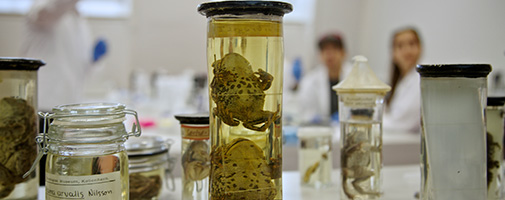Laboratory methods
In the course DNA & life, as well as the project “DNA PÅ FORKANT”, students help to collect and analyze environmental DNA-samples, using real-time PCR-analysis. In “DNA PÅ FORKANT” the students also have the opportunity to extract the DNA from the collected eDNA samples, which is used for the real-time PCR-analysis itself.
Here you can read more about the different laboratory methods and techniques and find extra materials regarding their theoretical and practical use.
Environmental DNA, or eDNA, is defined as DNA obtained from a specific environment. Environmental DNA can be used to detect the presence of organisms based solely on their DNA traces, as all living organisms excrete DNA. This method has been used to study many different environments, including air, soil, water, ice, sediments, household dust and feces.
The method is used to examine the presence of different organism groups and even separate species. This makes the method particularly suited for monitoring and mapping the distribution of species – especially species that are especially interesting because they might be rare or cause problems. One of the many advantages of this method is the fact that only a single sample is needed from the environmental substrate in question, to investigate the presence of the species.
In the project behind DNA & life, DNA-traces from water samples are studied. The water samples are filtered through a Sterivex-filter, where a membrane in the filtration unit ensures that cell- and DNA-material is retained. After filtration, the DNA is preserved with 96% ethanol before it is extracted later.
Use of environmental DNA
Niras - mapping of biodiversity
In order to continue working with the environmental DNA-sample, it is necessary to extract the collected DNA, which is bound to the filtration membrane. This is done via DNA extraction or DNA purification, where the filtration membrane is treated with reagents and solutions that free the cells from the membrane and cause cell lysis. At the same time a protease is added, which helps to release and stabilize the DNA, so it is not degraded by various nucleases or similar enzymes.
The liquid, which is a mixture of cell debris, DNA, proteins, and other chemical components, must be purified so the DNA sample is as clean/pure as possible. This is typically done using a series of chromatographic steps, where the liquid is filtered using a membrane that can bind and release DNA, depending on the chemical environment.
Real-time PCR builds on the same principles as normal PCR. A mixture of reagents, needed for the actual reaction, is made. This mixture is called a master mix, and is made up of primers, probe, Taq Polymerase, nucleotides, buffer, and water. In studies looking for DNA-traces from specific species, specifically designed primers and probes that are designed to react only to the DNA of the specific species is used.
The master mix is added to the DNA-samples you want to examine. In this case the master mix is added to the environmental DNA-sample. The master mix is also added to two other sample types – a positive control and a negative control. The positive control sample contains extracted tissue from the species in question, while the negative control sample only contains water.
Book teaching
Book teaching through this link.



